人教六年级小升初英文必背知识点汇总条
史上最全的小升初英语必考知识点大全
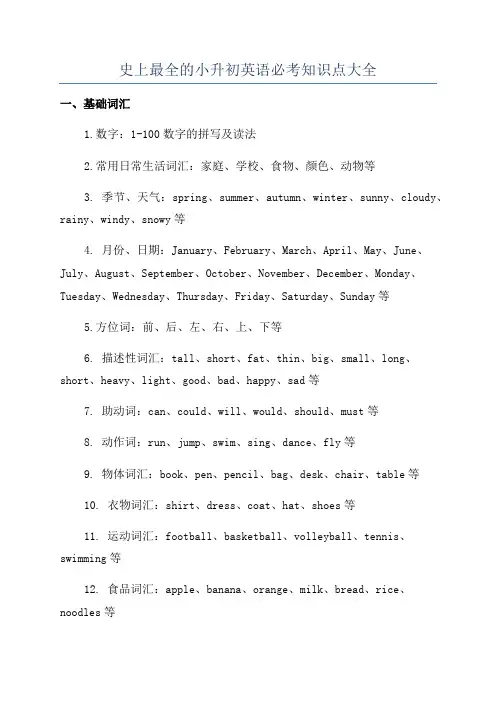
史上最全的小升初英语必考知识点大全一、基础词汇1.数字:1-100数字的拼写及读法2.常用日常生活词汇:家庭、学校、食物、颜色、动物等3. 季节、天气:spring、summer、autumn、winter、sunny、cloudy、rainy、windy、snowy等4. 月份、日期:January、February、March、April、May、June、July、August、September、October、November、December、Monday、Tuesday、Wednesday、Thursday、Friday、Saturday、Sunday等5.方位词:前、后、左、右、上、下等6. 描述性词汇:tall、short、fat、thin、big、small、long、short、heavy、light、good、bad、happy、sad等7. 助动词:can、could、will、would、should、must等8. 动作词:run、jump、swim、sing、dance、fly等9. 物体词汇:book、pen、pencil、bag、desk、chair、table等10. 衣物词汇:shirt、dress、coat、hat、shoes等11. 运动词汇:football、basketball、volleyball、tennis、swimming等12. 食品词汇:apple、banana、orange、milk、bread、rice、noodles等二、语法知识1.时态:一般现在时、一般过去时、一般将来时、现在进行时等2.名词单复数:可数名词和不可数名词的区分3. 冠词:a/an、the的用法4.代词:主格、宾格、所有格等5.形容词和副词的比较级和最高级:比较级、最高级的构成及用法6. 冠词:a、an、the的用法7.状语从句:时间状语从句、地点状语从句、原因状语从句等8. 定语从句和定语从句中关系代词的使用:that、which、who、whom、whose等9. 情态动词的用法:can、could、may、might、must、should、will等三、阅读理解1.短文理解:包括对短文的主旨、细节、主题等进行理解和推断2.阅读策略:如猜词法、上下文理解、主题理解等技巧3.阅读题型:选择题、判断题、填空题等不同类型的问题四、写作表达1.句子构成:主语、谓语、宾语、状语等句子成分的构成2.写作技巧:描述人物、描述动物、描述事物等写作技巧3.话题表达:日常生活、学习生活、周末活动等常见话题的表达方式。
人教版六年级英语小升初必考知识点
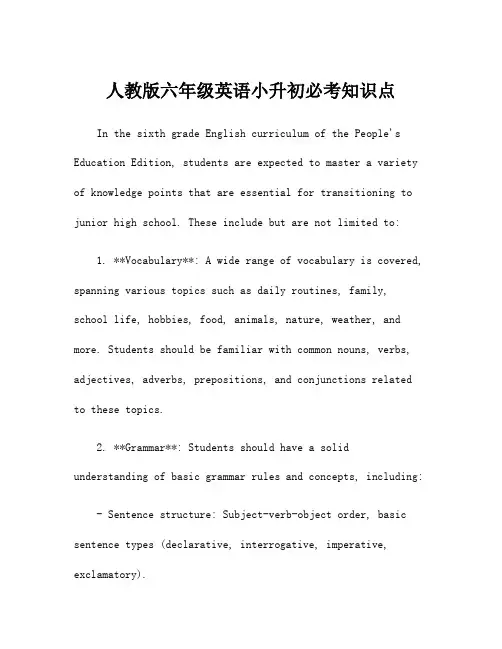
人教版六年级英语小升初必考知识点In the sixth grade English curriculum of the People's Education Edition, students are expected to master a variety of knowledge points that are essential for transitioning to junior high school. These include but are not limited to:1. **Vocabulary**: A wide range of vocabulary is covered, spanning various topics such as daily routines, family, school life, hobbies, food, animals, nature, weather, and more. Students should be familiar with common nouns, verbs, adjectives, adverbs, prepositions, and conjunctions related to these topics.2. **Grammar**: Students should have a solid understanding of basic grammar rules and concepts, including: - Sentence structure: Subject-verb-object order, basic sentence types (declarative, interrogative, imperative, exclamatory).- Parts of speech: Nouns, pronouns, verbs, adjectives, adverbs, prepositions, conjunctions, and interjections.- Verb tenses: Present simple, present continuous, past simple, future with "will."- Pronouns: Personal pronouns (subject and object forms), possessive pronouns, reflexive pronouns.- Articles: Definite and indefinite articles (the, a/an).- Plurals: Regular and irregular plural nouns.- Comparative and superlative forms of adjectives and adverbs.- Modal verbs: Can, could, may, might, must, shall, should, will, would.- Simple future tense with "be going to."- Reported speech: Statements, questions, commands, and requests.- Conditional sentences: Zero, first, and second conditionals.- Passive voice: Present and past passive forms.3. **Reading Comprehension**: Students are expected to understand and interpret various types of texts, including narratives, dialogues, informational passages, and poems. They should be able to:- Identify main ideas and supporting details.- Make predictions based on context clues.- Infer the meaning of unfamiliar words.- Recognize literary devices such as similes, metaphors, personification, and onomatopoeia.- Summarize texts and identify the author's purpose.4. **Writing Skills**: Students should be able to express themselves effectively in writing, demonstrating:- Proper sentence structure and punctuation.- Clear organization of ideas into paragraphs.- Use of transition words and phrases to connect ideas.- Descriptive language to create vivid imagery.- Writing various types of texts, including narratives, descriptions, recounts, letters, and instructions.- Proofreading and editing skills to improve the clarity and coherence of their writing.5. **Listening and Speaking**: Students should be able to listen to and understand spoken English in different contexts, such as classroom instructions, conversations, stories, and presentations. They should also be able to communicate orally by:- Asking and answering questions.- Participating in discussions and role-plays.- Giving presentations on familiar topics.- Following multi-step instructions.- Pronouncing words and phrases accurately.6. **Cultural Awareness**: While primarily focused on language skills, the curriculum may also include aspects of cultural awareness, such as learning about English-speaking countries, their customs, traditions, and holidays.Overall, mastery of these knowledge points prepares students for success in junior high school and lays a solid foundation for further English language learning.。
六年级下册英语小升初必背知识点
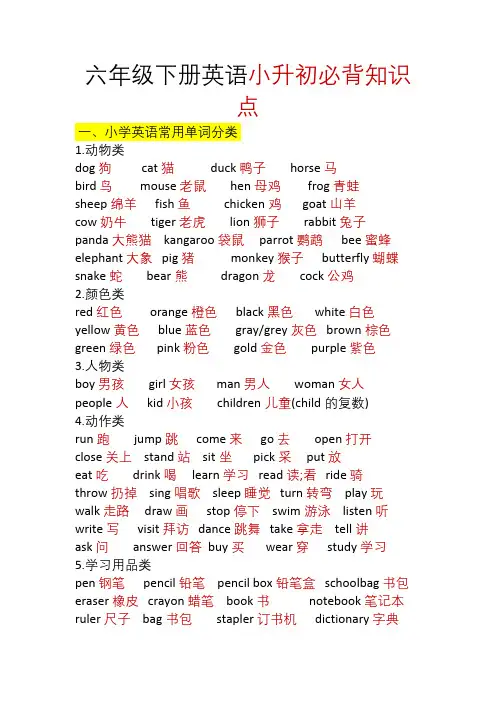
六年级下册英语小升初必背知识点一、小学英语常用单词分类1.动物类dog 狗 cat 猫 duck 鸭子 horse 马bird 鸟 mouse 老鼠 hen 母鸡 frog 青蛙sheep 绵羊 fish 鱼 chicken 鸡 goat 山羊cow 奶牛 tiger 老虎 lion 狮子 rabbit 兔子panda 大熊猫 kangaroo 袋鼠 parrot 鹦鹉 bee 蜜蜂elephant 大象 pig 猪 monkey 猴子 butterfly 蝴蝶snake 蛇 bear 熊 dragon 龙 cock 公鸡2.颜色类red 红色 orange 橙色 black 黑色 white 白色yellow 黄色 blue 蓝色 gray/grey 灰色 brown 棕色green 绿色 pink 粉色 gold 金色 purple 紫色3.人物类boy 男孩 girl 女孩 man 男人 woman 女人people人 kid 小孩 children儿童(child的复数)4.动作类run 跑 jump 跳 come 来 go 去 open 打开close 关上 stand 站 sit坐 pick 采put 放eat 吃 drink 喝 learn 学习 read 读;看 ride 骑throw 扔掉 sing 唱歌 sleep 睡觉 turn 转弯 play 玩walk 走路 draw 画 stop 停下 swim游泳 listen 听write 写 visit 拜访 dance 跳舞 take 拿走 tell 讲ask 问 answer 回答 buy 买 wear 穿 study 学习5.学习用品类pen 钢笔 pencil 铅笔 pencil box 铅笔盒 schoolbag 书包eraser 橡皮 crayon 蜡笔 book 书 notebook 笔记本ruler 尺子 bag书包 stapler 订书机 dictionary 字典6.交通工具类car小汽车 bike自行车 subway地铁 bus公共汽车taxi出租车 boat小船 motorbike摩托车 plane飞机ship船 train火车7.数词类one 一 two 二 three三 four 四five 五 six六 seven 七 eight 八nine 九 ten十 eleven 十一 twelve十二first第一 second第二 third第三 fourth第四fifth第五 sixth第六 seventh第七 eighth第八ninth第九 tenth第十 eleventh第十一 twelfth第十二they他/她/它们 we我们 my我的 your你的;你们的his他的 her她的 its它的 our我们的their他/她/它们的24.乐器类Violin 小提琴 piano钢琴 guitar吉他 pipa琵琶erhu 二胡 flute长笛25.房间类study书房 bedroom卧室 living room/sitting room客厅bathroom浴室 kitchen厨房 dining room饭厅toilet/washroom洗手间26.球类badminton羽毛球 soccer/football足球 2baseball棒球volleyball排球 basketball篮球 tennis网球table tennis/ping-pong乒乓球27.天气类sunny晴朗的 snowy下雪的 cloudy多云的 rainy有雨的windy有风的 wet潮湿的 dry干燥的 cold冷的hot热的 warm暖和的 cool凉爽的28.疾病类headache头痛 toothache牙痛 stomachache胃痛cold感冒 fever发烧 cough咳嗽29.季节及月份类spring春天 summer夏天 autumn/fall秋天 winter冬天January一月 February 二月 March三月 April四月May五月 June六月 July 七月 August 八月September九月 October十月 November十一月 December十二月30.地点及方位类station车站 cinema电影院 hospital医院 library图书馆park公园 shop商店 zoo动物园 bookstore书店museum博物馆 bank银行 supermarket超市 cafe咖啡厅farm农场 school学校 post office邮局 restaurant餐馆west 西方 east东方 south南方 north北方二、小学英语常见的反义词(对应词)1.名词day(白天)—night(黑夜) boy(男孩)—girl(女孩)man(男人)—woman(女人) cock(公鸡)—hen(母鸡)Mr(先生)—Mrs(夫人) father(父亲)—mother(母亲) uncle(叔叔)—aunt(阿姨) brother(兄;弟)—sister(姐;妹) son(儿子)—daughter(女儿) east(东方)—west(西方) grandfather(祖父/外祖父)—grandmother(祖母/外祖母)2.动词come(来)—go(去) cry(哭)—laugh/smile(笑)open(开)—close(关) begin/start(开始)—finish/end(结束) 4y(买)—sell(卖) forget(忘记)—remember(记住)sit(坐)—stand(站) take(拿走)—bring(带来)ask(问)—answer(回答) pull(拉)—push(推)sleep(睡觉)—wake(醒来) turn on(打开)—turn off(关掉) get on(上车)—get off(下车)3.副词yes(是)—no(不) here(这儿)—there(那儿)first(第一)—last(最后) up(向上)—down(向下)now(现在)—then(那时)4.介词inside(在···里面)—outside(在···外面)on(在···上面)—under(在···下面)above(在···上方)—below(在···下方)after(在···之后)—before(在···之前)in front of(在···前面)—behind(在···后面)with(有)—without(没有)5.形容词big(大的)—small(小的) black(黑色的)—white(白色的) bad(坏的)—good(好的) beautiful(美丽的)—ugly(丑陋的) busy(忙碌的)—free(空闲的) cold(冷的)—hot(热的)cool(凉爽的)—warm(温暖的) clean(干净的)—dirty(脏的) clever(聪明的)—stupid(笨的) cheap(便宜的)—expensive(昂贵的)dark(黑暗的)—bright(明亮的) dangerous(危险的)—safe(安全的easy(容易的)—difficult(困难的) far(远的)—near(近的)fat(胖的)—thin(瘦的) happy(高兴的)—sad(悲伤的) hard(硬的)—soft(软的) hungry(饿的)—full(饱的)late(晚的)—early(早的) left(左边的)—right(右边的)little(小的)—large(大的) light(轻的)—heavy(重的)long(长的)—short(短的) more(更多的)—less(更少的) new(新的)—old(旧的) old(年老的)—young(年轻的) poor(贫穷的)—rich(富有的) quiet(安静的)—noisy(吵闹的) right(对的)—wrong(错的) same(相同的)—different(不同的)strong(强壮的)—weak(虚弱的) tall(高的)—short(矮的) thick(厚的)—thin(薄的)三、小学英语常见同音词deer(鹿)—dear(亲爱的) right(正确的)—write(写)know(知道)—no(不) sun(太阳)—son(儿子)four(四)—for(为) here(这里)—hear(听见)meat(肉)—meet(见面) father(父亲)—farther(更远) where(在哪里)—wear(穿着) hour(小时)—our(我们的) week(星期)—weak(虚弱的) their(他们的)—there(那里) pair(一双)—pear(梨) too(也)—two(二)—to(到;往;去)buy(买)—by(表示方式;靠近)—bye(再见)四、小学英语常用短语go home 回家 go to school 去上学get up起床 go to bed上床睡觉have/eat breakfast吃早餐 have/eat dinner 吃晚餐have/eat lunch 吃午餐 go shopping 购物go hiking 去远足 go camping 去野营go swimming 去游泳 go fishing 去钓鱼go cycling 去骑自行车 go ice-skating 去滑冰go to the cinema 去电影院 go on a picnic 去野餐go straight 直走 turn left 向左转turn right 向右转 have classes 上课have/take an English class上英语课 learn/study English 学英语speak English说英语 clean the windows 擦窗户climb mountains 爬山 collect stamps 收集邮票cook the meals 做饭 cross the road 过马路do homework 做作业 do housework做家务wash the dishes 洗盘子 wash the clothes 洗衣服water the flowers 浇花 make the bed 整理床铺visit grandparents 探望(外)祖父母 watch TV 看电视draw pictures 画画 draw cartoons 画漫画pick apples 摘苹果 make a snowman 堆雪人sing English songs 唱英文歌曲 go for a walk 散步listen to music 听音乐 play chess 下棋play computer games 玩电脑游戏 play football 踢足球play basketball 打篮球 play badminton 打羽毛球play ping-pong 打乒乓球 play sports 进行体育运动play the piano 弹钢琴 play the violin 拉小提琴play the pipa 弹琵琶 read books看书read newspapers 看报纸 ride a bike 骑自行车ride a horse 骑马 iron the clothes 熨衣服fly a kite放风筝 do morning exercises做早操drink coffee喝咖啡 do kung fu练武术see a film 看电影 see a doctor看病have a cold感冒 wear warm clothes穿暖和的衣服take a deep breath深深吸一口气 count to ten数到十do word puzzles猜字谜 sweep the floor扫地take a shower洗淋浴 take a trip去旅行take pictures/photos拍照 come in进来slow down慢下来 look/watch out 小心;留神talk quietly 小声说话 take turns按顺序来keep to the right靠右 keep your desk clean保持你的书桌干净have a try试一试 sit down坐下up站起来 stay at home待在家里by bike骑自行车 by bus坐公共汽车on foot步行 the day before yesterday前天next week下周 last weekend上周末last night昨晚 this morning 今天早上on the first floor在一楼 teachers’office教师办公室computer room 计算机房 art room美术教室music class音乐课 comic book连环画册word book单词书 dining hall饭厅science museum科学博物馆 in front of在···前面五、小学英语常用单词缩写归类1. be动词和助动词缩写I am=I'm he is=he's you are=you'reI have=I've she is=she's I will=I'llyou have=you've it is=it's it will =it'll2.否定缩写are not=aren't has not=hasn't have not=haven'tdo not=don't does not=doesn't did not=didn't3.月份缩写January=Jan. February=Feb. March=Mar.April=Apr. May=May June=Jun.July=Jul. August=Aug. September=Sept.October=Oct. November=Nov. December=Dec.4.星期缩写Sunday=Sun. Monday=Mon. Tuesday=Tue. Wednesday=Wed. Thursday=Thur. Friday=Fri.Saturday=Sat.5.其他let us=let's there is=there's number=No.六、小学英语常见近义词辨析1. look, see, watch, read(看,看见)look指提醒别人,引起注意的“看”。
六年级小升初英语知识点
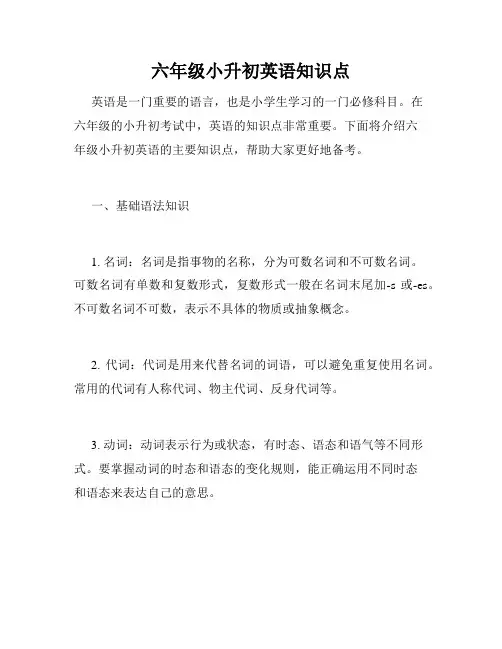
六年级小升初英语知识点英语是一门重要的语言,也是小学生学习的一门必修科目。
在六年级的小升初考试中,英语的知识点非常重要。
下面将介绍六年级小升初英语的主要知识点,帮助大家更好地备考。
一、基础语法知识1. 名词:名词是指事物的名称,分为可数名词和不可数名词。
可数名词有单数和复数形式,复数形式一般在名词末尾加-s或-es。
不可数名词不可数,表示不具体的物质或抽象概念。
2. 代词:代词是用来代替名词的词语,可以避免重复使用名词。
常用的代词有人称代词、物主代词、反身代词等。
3. 动词:动词表示行为或状态,有时态、语态和语气等不同形式。
要掌握动词的时态和语态的变化规则,能正确运用不同时态和语态来表达自己的意思。
4. 形容词和副词:形容词用来描述事物的特征或性质,副词则用来修饰动词、形容词或其他副词。
要注意形容词和副词的比较级和最高级形式的变化。
5. 介词:介词用来表示时间、地点、原因等关系,常常与名词或代词连用。
要掌握常用的介词及其搭配的用法。
二、阅读理解阅读理解是考察学生对英语文章的理解和推理能力的重要环节,主要包括词义理解、推断、主旨概括等方面。
1. 词义理解:通过上下文推断单词或短语的意思,掌握常用词汇的词义和用法。
2. 推断:根据文章中的信息进行推理,理解文章的逻辑结构和意义。
3. 主旨概括:概括文章的主要内容和中心思想,突出文章的重点和要义。
三、听力技巧在小升初英语考试中,听力是一个重要的考查内容。
要提高听力能力,需要掌握一些听力技巧。
1. 注意听力指令:仔细听题目要求,明确问题的要求。
2. 注意听力材料的关键信息:听力材料中会包含一些关键信息,比如数字、时间、地点等,要注意识别并记忆这些信息。
3. 掌握常见的听力形式:考试中常见的听力形式有听对话回答问题、听短文选择答案、听对话填空等,要熟悉这些形式,并掌握相应的解题技巧。
四、口语表达口语表达是英语学习的重要部分,也是小升初英语考试的一项内容。
要提高口语表达能力,可以进行一些口语练习和交流。
小升初知识点总结复习(素材)通用版英语六年级下册
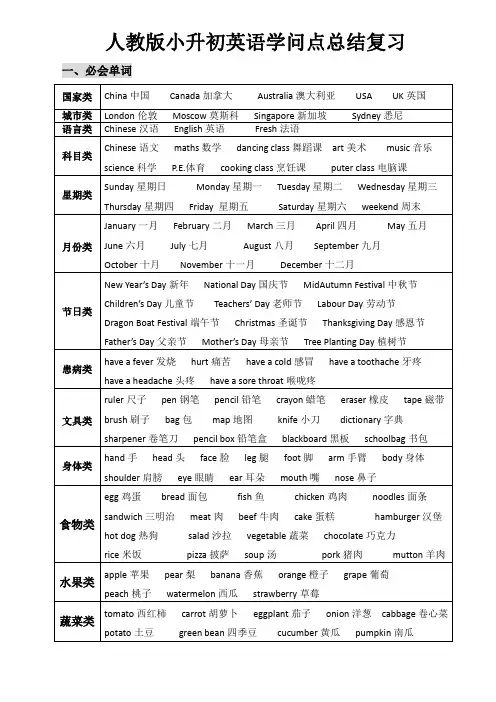
一、必会单词
国家类 China 中国 Canada 加拿大
Australia 澳大利亚 USA UK 英国
城市类 London 伦敦 Moscow 莫斯科 Singapore 新加坡
语言类 Chinese 汉语 English 英语
Fresh 法语
Sydney 悉尼
科目类 Chinese 语文 maths 数学 dancing class 舞蹈课 art 美术 music 音乐
go cycling 去骑自行车
in front of 在...前面
fly a kite 放风筝
lots of 很多
go boating 去划船
eat breakfast 吃早饭
go straight 直走
eat lunch 吃午饭
have a cold 感冒
eat dinner 吃晚饭
pay attention to 留意
science 科学 P.E.体育 cooking class 烹饪课
puter class 电脑课
星期类 Sunday 星期日
Monday 星期一 Tuesday 星期二 Wednesday 星期三
Thursday 星期四 Friday 星期五
Saturday 星期பைடு நூலகம் weekend 周末
January 一月 February 二月 March 三月 April 四月
tall 高的 short 矮的 fat 胖的 thin 瘦的 healthy 健康的 good 好的
外貌类 beautiful 美丽的 pretty 美丽的 nice 好的 strong 强壮的 old 老的
人教六年级小升初英文必背知识点汇总条
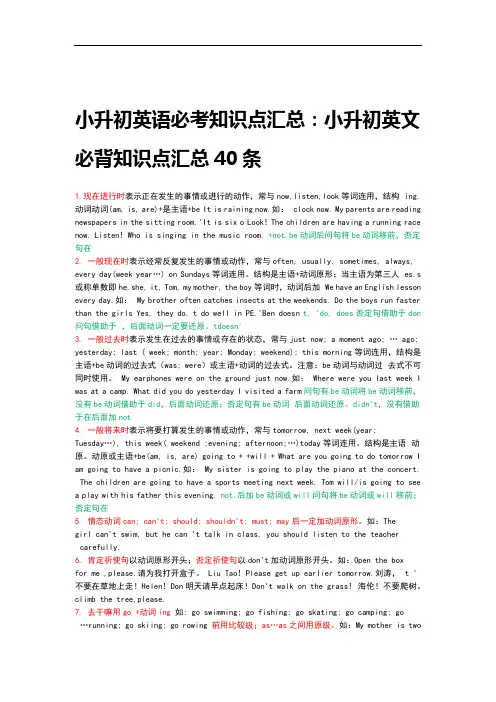
小升初英语必考知识点汇总:小升初英文必背知识点汇总40条1.现在进行时表示正在发生的事情或进行的动作,常与now,listen,look等词连用,结构ing.动词动词(am, is, are)+是主语+be It is raining now.如:clock now. My parents are reading newspapers in the sitting room.'It is six o Look! The children are having a running race now.Listen! Who is singing in the music room.+not.be动词后问句将be动词移前,否定句在2. 一般现在时表示经常反复发生的事情或动作,常与often, usually, sometimes, always, every day(week year…) on Sundays等词连用。
结构是主语+动词原形;当主语为第三人es.s 或称单数即he,she, it, Tom, my mother, the boy等词时,动词后加We have an English lesson every day.如:My brother often catches insects at the weekends.Do the boys run faster than the girls Yes, they do.t do well in PE.'Ben doesn t, 'do, does否定句借助于don 问句借助于,后面动词一定要还原。
tdoesn'3. 一般过去时表示发生在过去的事情或存在的状态,常与just now; a moment ago; … ago; yesterday; last ( week; month; year; Monday; weekend); this morning等词连用,结构是主语+be动词的过去式(was; were)或主语+动词的过去式。
六年级英语知识点小升初
六年级英语知识点小升初六年级英语学科知识点是小学生小升初考试中必备的内容之一。
在这个学科中,学生需要掌握英语语法、词汇、阅读理解等方面的知识。
以下是六年级英语知识点的详细介绍:一、语法知识点1. 时态:六年级学生需要掌握一般现在时、一般过去时、一般将来时等各种时态的用法。
例如,一般现在时用于表达经常性的动作或现实情况,一般过去时用于过去发生的动作或状态,一般将来时用于表示将来的动作或计划。
2. 人称代词和物主代词:学生需要熟练掌握一、二、三人称代词和相应的物主代词的用法。
例如,I是一人称代词,用于指代自己;my是相应的物主代词,表示“我的”。
3. 疑问句和否定句:学生需要了解疑问句和否定句的构成和用法。
例如,疑问句一般在句首加助动词或疑问代词,表示一个问题;否定句一般在动词前加not,表示否定的意思。
4. 比较级和最高级:学生需要学会比较级和最高级的构成和比较等级的用法。
例如,比较级用于比较两个人或事物的特征,最高级用于比较三个或三个以上的人或事物。
二、词汇知识点1. 常用词汇:学生需要掌握一些常用的英语词汇,如动物、植物、食物、颜色、数字、家庭成员、学校用品等。
通过记忆和练习,学生可以提高对词汇的记忆和理解能力。
2. 动词短语:学生需要学习一些常用的动词短语,如go to school(去上学)、have breakfast(吃早餐)、play basketball(打篮球)等。
这些短语在口语和书面语中都有广泛的应用。
三、阅读理解知识点1. 阅读材料:学生需要通过阅读各种类型的文章,如故事、新闻、广告等,提高阅读理解能力。
通过阅读,学生可以了解不同的事物和情况,并从中获取相关信息。
2. 理解问题:学生需要学会阅读文章后回答问题的技巧。
他们需要仔细阅读每个问题,并从文章中找到相关的信息。
通过练习,学生可以提高问题解答的能力。
以上是六年级英语知识点的简要介绍。
学生可以通过课堂上的学习和课后的练习来巩固和提高自己的英语水平。
六年级小升初知识点英语
六年级小升初知识点英语英语作为一门重要的学科,对于六年级的学生来说尤为重要,因为六年级是小学最后一年,也是升入初中的关键时期。
下面将为大家总结六年级小升初英语的重点知识。
一、语法知识点1. 时态:六年级英语的时态主要包括一般现在时、一般过去时、现在进行时、一般将来时和过去进行时。
2. 名词和代词:六年级需要掌握单数和复数名词的变化规则以及人称代词和物主代词的用法。
3. 形容词和副词:学生需要区分形容词和副词,并学会形容词和副词的比较级和最高级形式。
4. 句型结构:学生需要掌握各种基本句型的构造,例如肯定句、否定句、疑问句等。
二、词汇知识点1. 单词拼写:学生需要掌握并正确拼写常见的英语单词,如动物、水果、食物等。
2. 动词短语:学生需要学会使用常见的动词短语,如go to school、have breakfast等。
3. 时钟时间:学生需要掌握常见的时钟时间表达,包括整点、半点和刻钟。
4. 季节和月份:学生需要掌握四季和十二个月份的英文表达。
三、阅读理解阅读理解是英语学习中非常重要的一部分,六年级的学生需要通过阅读短文来获取信息并回答相关问题。
建议学生多做阅读理解训练,提高阅读速度和理解能力。
四、口语和听力六年级的学生需要养成多听多说的习惯,培养英语语感和口语表达能力。
可以通过和同学或老师进行对话练习,或者听英语歌曲、看英语电影来提升听力技巧。
五、写作能力六年级的学生需要培养基本的写作能力,可以从简单的日记、信件和作文开始,逐步提升写作水平。
建议多读优秀的英语作文,并学习其中的表达方式和句型结构。
总结:六年级小升初英语的知识点主要包括语法、词汇、阅读理解、口语和听力以及写作能力。
学生需要通过练习和积累来提升自己的英语水平,为进入初中打下坚实的基础。
以上是六年级小升初英语的相关知识点,希望对大家的学习有所帮助。
祝愿大家在英语学习中取得好成绩!。
人教版小升初英语复习重点六年级毕业生英语复习资料
人教版小升初英语复习重点六年级毕业生英语复习资料有很多重要的语法,时态是中很重要却又有难度的知识点,那么六年级的同学应该怎样在考试之前好这局部呢?下面是由的人教版小升初英语复习重点,希望对您有用。
(1)句中be动词和动词一般情况下只能有一种而且也必须有一种。
如:The children are very happy on Christmas Day .She often does some housework at the weekend .(2)一般现在时中的be动词:一般用原形:am is aream用于第一人称单数(I);is用于第三人称单数(he she it和其他人名或称谓,如:Ben his sister等);are用于第二人称单数(you)和所有复数(包括第一人称复数we、第二人称复数you;第三人称复数they和其他复数,如the children 、 his parents等)。
(3)一般过去时中的动词:有两种情况:第一种情况:主语是第三人称单数(he she it 和其他,如Helen 、her cousin 等),动词后一般加s或es。
第二种情况:主语不是第三人称单数,动词都用原形。
(4)一般现在时判断依据(如何判断一个是一般现在时):△be动词是am、is、are△动词用原形或加s、es△没有时间状语或有usually、often、everyday、sometimes 等不是具体的时间(5)有用的的依据:Be动词是is、am ←→ 名词用原形(这里包括可数名词的单数和不可数名词)Be动词是are ←→ 名词加s或es动词加s或es ←→ 主语是第三人称单数动词用原形←→ 主语不是第三人称单数(6)情态动词:我们现在学过的情态动词有:can、must、should、would。
情态动词后动词总是用原形。
(不受其他任何条件影响)(1)句中be动词和动词一般情况下只能有一种而且也必须有一种。
英语六年级小升初考试复习资料归纳
英语六年级小升初考试复习资料归纳英语六年级小升初考试复习资料归纳小学英语作为一门语言类学科,自然在众多科目当中是拥有重要地位的。
所以家长们这个时候千万要重视,因为这不仅是为了提高孩子们的考试成绩,更是为以后初高中的学习奠定好基础。
下面小编给大家带来英语六年级小升初考试复习资料,希望对大家有所帮助!小升初英语知识点1:动词行为动词、be动词、情态动词。
(1)行为动词原形、+s/es、+ed、+ing,具体判断方法如下:(2)be动词a、Am--was Is --was Are--were 口诀:我用am, 你用are, is用在他她它,所有复数全用are。
b、肯定和否定句I am (not) from London. He /She is(not) a teacher. My hair is(not) long. Hereyes are(not) small.c、一般疑问句Am I …? Yes, you are. No, you aren't. Are you/they…? Yes,we/ they are.No,we/ they aren't. Is the cat fat? Yes, it is. No, it isn't.is、am、are为一类,一般用于一般现在时、现在进行时和一般将来时中。
was和were为另一类,一般用于一般过去时。
(3)情态动词can、must、should、would、may。
情态动词后动词总是用原形。
(不受其他任何条件影响)小升初英语知识点2:形容词(包括副词)形容词表示某一事物或的特征,副词表示某一动作的特征。
形容词和副词只有两种形式:原形和+er。
未作比较的情况下就用原形,比较时就+er。
两个重要特征:as……as中间一定用原形,有than的时候一定+er。
小升初英语知识点3:人称代词和物主代词人称代词物主代词单数复数单数复数主格宾格主格宾格形容词性(短)名词性(长)形容词性(短)名词性(长) 第一人称Imeweusmymineourours第二人称youyouyouyouyouryoursyouryours第三人称hehimtheythemhishistheirtheirssheherherhersitititsits人称代词:有主格和宾格之分。
- 1、下载文档前请自行甄别文档内容的完整性,平台不提供额外的编辑、内容补充、找答案等附加服务。
- 2、"仅部分预览"的文档,不可在线预览部分如存在完整性等问题,可反馈申请退款(可完整预览的文档不适用该条件!)。
- 3、如文档侵犯您的权益,请联系客服反馈,我们会尽快为您处理(人工客服工作时间:9:00-18:30)。
小升初英语必考知识点汇总:小升初英文必背知识点汇总40条1.现在进行时表示正在发生的事情或进行的动作,常与now,listen,look等词连用,结构是主语+be动词(am, is, are)+动词ing.如:It is raining now.It is six o’clock now. My parents are reading newspapers in the sitting room. Look! The children are having a running race now.Listen! Who is singing in the music room.问句将be动词移前,否定句在be动词后+not.2. 一般现在时表示经常反复发生的事情或动作,常与often, usually, sometimes, always, every day(week year…) on Sundays等词连用。
结构是主语+动词原形;当主语为第三人称单数即he,she, it, Tom, my mother, the boy等词时,动词后加s或es.如:We have an English lesson every day.My brother often catches insects at the weekends.Do the boys run faster than the girls Yes, they do.Ben doesn’t do well in PE.问句借助于do, does否定句借助于don’t,doesn’t,后面动词一定要还原。
3. 一般过去时表示发生在过去的事情或存在的状态,常与just now; a moment ago; … ago; yesterday; last ( week; month; year; Monday; weekend); this morning等词连用,结构是主语+be动词的过去式(was; were)或主语+动词的过去式。
注意:be动词与动词过去式不可同时使用。
如:My earphones were on the ground just now.Where were you last week I was at a camp.What did you do yesterday I visited a farm问句有be动词将be动词移前,没有be动词借助于did,后面动词还原;否定句有be动词在后面加not,没有借助于didn't后面动词还原。
4. 一般将来时表示将要打算发生的事情或动作,常与tomorrow, next week(year; Tuesday…), this week( weekend ;evening; afternoon;…)today等词连用。
结构是主语+be(am, is, are) going to + 动原或主语+will +动原。
如:What are you going to do tomorrow I am going to have a picnic.My sister is going to play the piano at the concert.The children are going to have a sports meeting next week.Tom will/is going to see a play with his father this evening.问句将be动词或will移前;否定句在be动词或will后加not.5. 情态动词can; can’t; should; shouldn’t; must; may后一定加动词原形。
如:The girl can’t swim, but he can ’t talk in class, you should listen to the teacher carefully.6. 肯定祈使句以动词原形开头;否定祈使句以don’t加动词原形开头。
如:Open the box for me ,please.请为我打开盒子。
Liu Tao! Please get up earlier tomorrow.刘涛,明天请早点起床!Don’t walk on the grass!不要在草地上走!Helen! Don’tclimb the tree,please.海伦!不要爬树。
7. 去干嘛用go +动词ing 如: go swimming; go fishing; go skating; go camping; go running; go skiing; go rowing…前用比较级;as…as之间用原级。
如:My mother is two years younger than my father.我妈比我爸年轻两岁。
Liu Tao jumps as far as Ben.刘涛跳得和本一样远。
9. 喜欢做某事用like +动词ing或like+ to + 动原。
如: Su Yang likes growing flowers.苏阳喜欢种花。
The children like toplay with lanterns at Spring Festival.孩子们喜欢在春节去玩花灯。
10. 想要做某事用 would like +to+动原或want + to +动原。
I’d like to visit the History Museum.=I want to visit the History Museum.11. some 用于肯定句中,在否定句和问句中改为any,但当表示委婉语气时仍用如:Can I have some writing paper Would you like some orange juice12.人称代词主格做主语用,一般放在句首或动词前,主格分别是 I you he she it we you they。
宾格做宾语用,一般放在动词或介词后如:Open them for me.Let us …, join me等。
宾格分别是me you him her it usyou them。
形容词性物主代词放在名词前,不能单独使用,分别是my your his her its our your their。
名词性物主代词相当于形物加名词,它只能单独使用后面不好加名词,分别是mine yours his hers its ours yours theirs。
13. 介词后要么不加动词,加动词只能加动词ing形式,如:be good at running; do well in jumping;14. 季节前,月份前用介词in,如:in summer;in March,具体的哪一天如星期几,几月几日用介词on如:on Saturday; on the second of April; on Wednesdaymorning,在几点钟前用介词at如: at a quarter to four; 只在上下午晚上用in 如:in the morning/ afternoon/ evening; 但在夜间用at night。
另:季节,月份和星期前不好加the.15. 名词复数构成的方法有规则的有(1)直接在名词后加s如orange—oranges; photo—photos;(2) 以x, s, sh, ch 结尾的加es如:box—boxes; glass—glasses; waitress —waitresses;watch—watches; peach--peaches(3) 以辅音字母加y结尾的改y为i加es如:study—studies;library—libraries; hobby—hobbies; family—families;(4)以f, fe结尾的改f, fe 为v+es如:knife—knives; thief—thieves(注:以o结尾的我们学过的只有mango加es, mango—mangoes其余加s,)不规则的有:man—men; woman—women; people—people; child—children16. 动词第三人称单数的构成(1)直接在动词后加s如:run—runs;dance—dances(2)以s,sh,ch,o结尾的加es如:do—does;go—goes;wash—washes;catch —catches (3)以辅音字母加y结尾的改y为i加es如:study—studies; carry—carries;17. 现在分词的构成(1)直接在动词后加ing如:sing—singing;ski—skiing;(2)双写词尾加ing如:swim—swimming;jog—jogging;run—running;(3)以不发音的e结尾的去e加ing如:ride—riding; dance —dancing; make—making;18. 规则动词过去式的构成(1)直接在动词后加ed,如:clean—cleaned; milk—milked; play—played;(2)以e结尾的直接加d如:dance—danced; taste—tasted;(3) 以辅音字母加y结尾的改y为i加ed如:study—studied;carry—carried;(4)双写词尾加ed如:stop—stopped; jog—jogged;不规则的有am,is—was; are—were; do,does—did; have,has—had; go—went; meet—met; sit—sat; see—saw; get—got; tell—told; run—ran; come—came; steal—stole; read—read;19.形容词副词比较级的构成规则的(1)直接在形容词或副词后加er如;small—smaller; low—lower;(2)以e结尾的加r如:late—larer;(3)双写词尾加er 如:big—bigger; thin —thinner; fat—fatter;(4) 以辅音字母加y结尾的改y为i加er如:heavy—heavier; early—earlier;不规则的有:good, well—better(最高级为best); many, much--- more(最高级为most); far---farther;与snow的用法(1)作为名词意思是雨水和雪是不可数名词如:There is a lot of rain there in spring. 那儿的春天有很多雨水。
